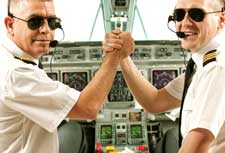Safety Culture More Than Policies and Procedures

In some places within the aviation industry, people believe that “safety culture” looks like a lot of rules and regulations. It looks like “the man” or a bunch of nerdy pencil pushers.
I don’t believe that’s what our safety culture does or should look like. I believe safety cultures in the aviation industry can look like so much more.
- It should look more like a community.
- It should look like a team.
- It should look like a family.
A safety culture should be a group of people who together adhere to strict safety standards and practices because of a deep sense of caring for one another and teamwork.
Related Aviation Safety Culture Articles
- What Is Safety Culture in Aviation Risk Management
- 6 Types of Safety Culture in Aviation Safety Management Systems
- 5 Simple Tips to Improve Aviation Safety Reporting Cultures
Aviation Safety Programs Should Enhance Safety Culture
Aviation safety programs are not solely about mitigating financial and human losses. Safety culture within the aviation industry is about caring for the health and well-being of
- pilots,
- crews,
- contractors, and
- passengers.
It’s about humanity.
The aviation community is a group of people from all around the world who share a common interest. That’s a powerful thing! There are people
- from every country,
- of every religion,
- young and old,
- men and women, and
- we’re all captivated by the magic of flight.
We’ve all felt that wonder and amazement as we look to the skies. It brings us together. Don’t we want to take care of each other? Safety culture is a culture of caring. We want to make sure nothing happens to our fellow brothers and sisters in aviation.
Safety Cultures Impose Responsibilities

We should all do our part to ensure we abide by safe operating procedures. By following safety policies and procedures thoroughly and diligently, we are making sure we not only keep ourselves safe but keep others safe as well. We are also leading by example.
Safety culture needs to be embraced and emulated by both those new to aviation and seasoned veterans alike. By always maintaining high standards and doing things properly, we’re showing those around us that it’s important and even “cool” to follow the rules.
We need to be sure we’re not slacking off or cutting corners and teaching those looking up to us bad habits. Professionalism and safety standards are something to look up to, and we should all strive to be the best we can be.
We should look out for each other as well. We’re all on the same team and working toward the same goals.
It’s in your best interest to make sure those around you practice proper safety techniques. For example, if you’re doing everything correctly, but someone else isn’t paying attention and rolls through a taxiway they were told to hold short of, you and/or your plane can be inadvertently injured. That’s why encouraging others to follow guidelines and care about safety can make a big difference.
Related Aviation Safety Culture Articles
- How Top Management Kills Aviation Safety Culture - With Examples
- 20 Indicators What Good Aviation Safety Culture Looks Like [With Free Checklist]
- 6 Signs of a Mature Aviation Safety Culture - With Resources
Accountability Is Enforced in Healthy Safety Cultures
When encouragement fails, there should be consequences for the culture. The macho hot-shot who watched too much Top Gun and did things his own way needs to be shown that the community at large doesn’t appreciate someone risking safety. It’s not appealing and won’t be tolerated.
Instead, the renegades or rebellious few need to see that everyone values safety and there’s no shame in playing by the rules. After all, many communities and organizations outside of aviation take pride in following procedures. Football players need to memorize plays. It might not be “cool” to stay home and study, but when it comes to game day, the players who do things correctly are the ones looked up to.
Health Safety Cultures Don't Dwell on Punitive Measures
Safety culture isn’t just about fines and penalties and mundane rules and checklists.
- It’s about community.
- It’s about a sense of pride in doing things properly.
- It’s about caring for each other and having the backs of our brothers and sisters in aviation.
- Health safety cultures look like a tight-knit family that soars.
- It looks like something to be proud of and strive to be a part of.
What does your safety culture look like?
Safety cultures require considerable time and discipline to develop. When managers are unable to measure employee safety performance and employee participation in safety initiatives, then they have little ability to positively shape their safety culture.
Here is an excellent way to motivate employees to participate in the company's aviation SMS implementation.
Last updated July 2025.







